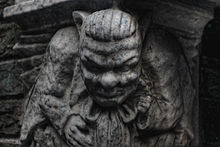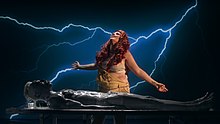Homunculus
The term homunculus (from the Latin homunculus, 'little man'; sometimes written homonculus) is the diminutive of «man» and is frequently used to illustrate an important arcana in alchemy. In the hermetic sense, it is an unknowable primordial actor, it can be seen as an entity or agent.
History
The term seems to have been first used by the alchemist Paracelsus, who once claimed to have created a homunculus while trying to find the Philosopher's Stone, one of whose benefits is 'eternal youth'. The creature would have been no more than a foot tall and did work normally associated with golems. However, after a short time, the homunculus turned on its creator and fled. The recipe to create it consisted of a bag of coal, mercury, fragments of skin or hair from any human or animal that the homunculus would be a hybrid of. All this had to be buried surrounded by horse manure for forty days, during which time the embryo would be formed in the bosom of the Earth.
There are also variants cited by other alchemists. One of them involved using mandrake. Popular beliefs held that this plant grew where the semen that the hanged emitted during the last convulsions before death (or putrefaction in alchemy) fell to the ground, in addition, its roots have a shape vaguely similar to a certain point to a human being. The root was to be collected before dawn on a Friday morning by a black dog, then washed and "fed" with milk and honey and, in some recipes, blood, whereupon it would eventually develop into a miniature human. that would guard and protect its owner.
A third method, cited by Dr. David Christianus at the University of Giessen during the 18th century, was to take an egg laid by a black hen, poke a small hole in the shell, replace a portion of the white the size of a bean by human sperm, seal the opening with virgin parchment, and bury the egg in dung on the first day of the March lunar cycle. Thirty days later, a miniature humanoid would hatch from the egg, helping and protecting its creator in exchange for a regular diet of lavender seeds and earthworms.[citation needed]
The term homunculus was later used in the discussion of conception and birth. In 1694, Nicolas Hartsoeker discovered "animaluncles" in the sperm of humans and other animals. The poor resolution of those early microscopes made the sperm head appear to be a complete man in miniature. As a result, theories were unleashed that the sperm was in fact a "little man" (homunculus) that was put inside a woman to grow into a child; these would later come to be known as the spermists. It was thought that since Adam all humanity was cloistered, that it would be transmitted to their descendants. This biological theory made it possible to coherently explain many of the mysteries of conception (for example, why you need two). However it was later pointed out that if the sperm was a homunculus, identical to an adult in all but size, then the homunculus must have its own sperm. This led to a reductio ad absurdum, with an "always down" chain of homunculi.
For his part, Goethe also popularized the term, since he called homunculus the small being created by Faust's former student, Wagner, through surgical operations.
Today the term is used in certain ways to describe systems that are believed to be powered by the "little men" within them. For example, the homunculus remains one of the leading theories of the origin of consciousness, which claims that it is a part (or process) of the brain whose job it is to be "you." The homunculus is frequently cited in cybernetics as well, for similar or similar reasons.
The sensory and motor homunculi
The term homunculus is also commonly used to describe a distorted human figure drawn to reflect the relative sensory space that our body parts represent in the cerebral cortex. The lips, tongue, hands, and feet are considerably more sensitive than other parts of the body, so the homunculus has extremely large lips, hands, and feet.
Wilder Penfield used a similar image to represent the body according to the surface of the motor cortex that controlled them in voluntary movement. This is called a Penfield homunculus. Sometimes viewed as a brain map of the body, the motor homunculus is actually a map of the proportional association of the cortex with the members of the body. It also reflects kinesthetic proprioception, that is, how the body feels when moving. It plays a major role in the phenomenon of phantom limbs and its opposite, the disappearance of limbs from conscious awareness present in certain brain lesions. For example, the thumb, which is used in thousands of complex activities, appears much larger than the thigh, which has relatively simple movement. The motor homunculus evolves with age and differs from person to person. The hand on the brain of a child is different from the hand on the brain of a pianist. These kinds of differences are open to introspection. For example, most people can flex and extend the tip of the thumb at will quite easily, but relatively few people can make similar movements with the rest of the fingers. The difference is due to variations in the functional organization of related brain areas.
The reasoning of the homunculus in the philosophy of mind
To the extent that homunculus reasoning explains a phenomenon in terms of the very phenomenon it is supposed to explain (Richard Gregory, 1987) it often falls into paralogism and diallel. Although not all theories that use homunculi deserve to be rejected, generally the reasoning of the homunculus tends to be fallacious, especially if the little men are attributed with carrying out complex tasks. In psychology and philosophy of mind, homunculus reasoning is extremely useful for detecting points where theories of mind fail or are incomplete.
Homunculus arguments are common in vision theory. Consider a person watching a movie. She sees the images as something foreign to her, projected on a screen. How can this happen? A simple theory might propose that light from the screen forms an image on the retinas of the eyes and that something in the brain sees it as if they were on the screen. The homunculus reasoning indicates that this is not a complete explanation because all it proposes is to place a new person or homunculus behind the eye, looking at the retina. A more sophisticated theory could propose that the images on the retinas are transmitted to the visual cortex where they are processed. Again, this cannot be a complete explanation because all it proposes is to place the homunculus in the brain, behind the cortex. In the theory of vision, the homunculus reasoning invalidates theories that do not explain "projection," the experience that separates the point of view from the things that are seen. (Adapted from Gregory, 1987/1990.)
A homunculus reasoning should be formulated in such a way that the conclusion is always that if a homunculus is needed, then the theory is wrong. After all, homunculi do not exist.
Very few people would propose that there really is a little man in the brain by examining brain activity. However, these proposals have been made, as in the "straw man" theories of the mind. Gilbert Ryle (1949) proposed that the human mind is recognized by its intelligent acts (see Ryle's regression). Ryle argued that if there is an inner being within the brain directing his own thoughts then this would lead to an absurd repetitive cycle or regression before a thought could occur:
According to the legend, whenever an agent does something smart, his act is preceded and directed by another internal act to consider a regulatory proposition appropriate to his practical problem.
[...] We must then say that for [the agent's] reflections on how to act intelligently, should this first reflect on how to correctly reflect on how to act? The infinity of this implicit regression shows that the application of adequacy does not imply the occurrence of a process of contemplation of this criterion.
The homunculus reasoning and the regression argument are often considered the same, but they are not. The homunculus reasoning states that if a little man is needed to complete a theory then it is wrong. The regression argument asserts that an intelligent agent would need to think before it could have a thought.
If the homunculus reasoning is applied to the intelligent agent problem, a slightly different result is obtained from the regression argument. The homunculus reasoning applied to Ryle's theory would be expressed in terms of whether the mental quality of "reflecting on things internally" can be explained by the theory that the mind consists of "intelligent acts" without the need for a homunculus. The answer, provided by Ryle's own logic, is that the internal reflection would need the homunculus to prevent it from going into infinite regress. Therefore with these assumptions the reasoning of the homunculus does not support the theory that the mind is entirely due to intelligent acts.
The example of Ryle's theory demonstrates another aspect of homunculus reasoning in which it is possible to attribute to the mind various properties such as "inner reflection" that are not universally accepted and use them argumentatively to claim that a theory about mind is invalid.
Cultural references
Literature
Homunculi appear in literature for several centuries:
- Pinocchio is clearly a Homunculum [chuckles]required]It could be a metaphor for alchemy. Even in several of the works mentioned below, such as The Foucalt pendulum of Umberto Eco and Fausto de Goethe, it is mentioned that the homunes desire and seek to become real people, such as Pinocho.
- In The Life and Opinion of the Knight Tristram Shandy by Laurence Sterne (volumen I, chapter II) there is a reference to the homuncle: "[...] the animal spirits, whose responsibility was to escort and go hand in hand with the homuncle and guide it safely to the designated place for reception. »
- In Foucault pendulum by Umberto Eco there are several references to the hommunes, especially detailed in the chapter that deals with the Druid rites carried out at a party in the castle of a rich rosacrucian. After performing a series of sensually stimulating hidden acts for a small audience, several homunes seem to be created, being unable to decide the protagonist Casaubon if they are wax or authentic.
- In the second part of Fausto, the German playwright Goethe makes Wagner, a disciple of Fausto creates a homuncle, which from there keeps long conversations with his creator and Mephistopheles.
- In her original study on the English novel Mary Shelley FrankensteinProfessor Radu Florescu points out that Shelley's father, William Godwin, and her husband, Percy Bysshe Shelley, were quite familiar with the life and work of alchemists such as Paracelso and others. Florescu also suggests that Johann Conrad Dippel, an alchemist born in Frankenstein Castle, who believes that it may have been the inspiration for Dr. Frankenstein, was a student of Dr. David Christianus.
- The German writer of terror Hanns Heinz Ewers used the mandragora recipe to create a counterpart as an inspiration for his 1911 novel. Alraunein which a prostitute becomes pregnant with the semen of a murderer hanged to create a woman without morality and conscience. Several cinematic adaptations of Alraune Over the years, Erich von Stroheim was the most recent in 1952. The 1995 film Species It also seems to be inspired in part in this variant of the legend of the homunocle.
- In the 1908 work of the English novelist W. Somerset Maugham The magicianOliver Haddo, a character based on the British occultist Aleister Crowley, is obsessed with the creation of the homune.
- U.S. author David H. Kellner wrote two works in which he appeared. One was a short story, A 20th-century counterpart, published in Amazing Stories in 1930, which described the creation of industrial-scale counterparts by a couple of misogynists. In the other, a novel entitled The Hungarian, published in 1949 by Prime Press of Philadelphia, retired Colonel Horatio Bumble created that being.
- In the fourth volume of The Alexandria Quartet (CleaLawrence Durrell, one of the characters, Capodistria, tells in a letter how an Austrian baron animated four homunes from alchemical knowledge. In the story, these beings were able to guess the future.
- In the book The Society of MindMarvin Minsky's idea is to rule out the idea of a little man within the mind that will serve to process stimuli and produce an answer, since this should have another little man inside and so in recursive form, which would make it into a scheme that could never end up diagramming.
- In the book The Dragon Rider of Cornelia Funke is a participant of history a homune called the Pata de Mosca, the work of an alchemist, who helps a dragon called "Lung" to find the shore of heaven. He also betrays a pseudo-dragon called Ortiga Abrasadora, in the same way the work of the same alchemist who created Pata de Mosca.
- Homunculus It's a Japanese Yamamoto Hideo sleeve. The protagonist, called Nakoshi, is a businessman who sleeps in his car every night, as if he were vagabond, however, one day a strange Gothic-looking character called Ito offers him the opportunity to win 700,000 yen in return to give him an intervention to his body known as “trepanation”, in order to see the homuncles of all people.
Cinema and television
- The counterpart has also been a popular theme in films for some time, starting with the 1916 series of six episodes in Germany. Homunculus.
- In the classic horror movie Frankenstein's girlfriend. Dr. Frankenstein's old professor, Dr. Praetorius, teaches him his own creations, a series of tiny humanoids preserved in jars, including a bishop, a king, a queen, a dancer, a mermaid and a devil. It is clearly understood that these are types of homunes, based on the creatures described in Sphinx of Emil Besitzny and Life of Paracelso by Franz Hartmann.
- In the American film The fantastic journey of Simbad (1974) the homunocle is portrayed as a miniature winged creature similar to a gargola, which turns out to be Simbad's nemesis.
- In various works of fantasy and science fiction, the term "homuncle" describes any human or human or human creature created by man through alchemy or magic.
- In the history of Fullmetal Alchemist, in its anime version, a hommune is the result of a failed human transmutation (trying to revive an unsuccessful dead man). In the second adaptation of the sleeve Full Metal Alchemist: Brotherhood, it is understood that the first homune was created by the master and owner of the father of the Elric brothers, who had no name at that time as he was a slave; and it was the homune who gave him the name Van Hohenheim; it is a kind of depiction of the Faust of Goethe; since they show the homune Father.
- In an episode of Humanoid Monster Bem, two homunes appear that at 5 years of life die. Also, in this anime it is mentioned that the 3 monsters were created with alchemy.
- In the history of Gosick, Albert de Blois, with the indications of the alchemist Leviathan, created a lot of homunes.
- There is a chapter of Ghost Hound that is called Brain Hommune, where it is explained what is a brain hommune.
- In the second episode of Todd & The Book Of Pure Evil they create a counterpart.
- In the anime and light novel Fate/stay night and his prequel Fate/Zero Irisviel von Einzbern and his daughter Illyasviel von Einzbern were supposedly homunic for the saint grial to materialize during the war of the 7 masters and their servants by the holy group.
- On the sleeve and anime Buso Renkin, the homunes are a metal alloy and alchemy that takes shape once own owners and are known as Kakugane
- In the film The Labyrinth of the Fauna, a homunocle is created with a mandragora root that gets under the bed on a plate with milk
Video Games
- The A.B.A character of the Guilty Gear fighting games series is considered a counterpart, as it was an artificial life form created by a scientist.
- In the SoulCalibur video game: Legends appear, on several occasions, alchemists, speaking of false human beings and hommunes. The Masked Emperor is a homunocle, created by Iska Farkas and moulded based on the image of her sister. Astaroth, therefore, is a golem. In this game of the saga is presented in its prototype form, so it only emits grunted.
- In the video game Shadows of Destiny we speak completely about the alchemical and theoretical concept of the homunculus, being the protagonist contacted by one in exchange for a mutual favor that in the beginning of the story is ignored, but then unveiled gradually, depending on the advances and endings taken within it.
- In the online MMORPG Ragnarok, a homunocle is a creature that assists the alchemist to confront his adversaries.
- In CAPCOM's Haunting Ground video game, Daniella is a homune that will try to kill the player to achieve the supposed perfection he wants.
- In Konami's video game, "Castlevania: Dawn of Sorrow", one of the collectible souls belongs to the Homunculus.
- In the game The Forest, one of the main enemies are mutant counterparts, which will try to kill the player.
Contenido relacionado
Leptomeninges
Panicle
Legionellosis











